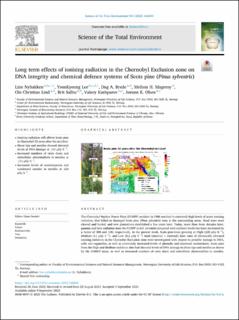| dc.contributor.author | Nybakken, Line | |
| dc.contributor.author | Lee, YeonKyeong | |
| dc.contributor.author | Brede, Dag Anders | |
| dc.contributor.author | Mageroy, Melissa | |
| dc.contributor.author | Lind, Ole Christian | |
| dc.contributor.author | Salbu, Brit | |
| dc.contributor.author | Kashparov, Valerii | |
| dc.contributor.author | Olsen, Jorunn Elisabeth | |
| dc.date.accessioned | 2023-10-31T07:06:01Z | |
| dc.date.available | 2023-10-31T07:06:01Z | |
| dc.date.created | 2023-10-05T11:14:49Z | |
| dc.date.issued | 2023 | |
| dc.identifier.citation | Science of the Total Environment. 2023, 904 1-11. | |
| dc.identifier.issn | 0048-9697 | |
| dc.identifier.uri | https://hdl.handle.net/11250/3099555 | |
| dc.description.abstract | The Chernobyl Nuclear Power Plant (ChNPP) accident in 1986 resulted in extremely high levels of acute ionising radiation, that killed or damaged Scots pine (Pinus sylvestris) trees in the surrounding areas. Dead trees were cleared and buried, and new plantations established a few years later. Today, more than three decades later, gamma and beta-radiation near the ChNPP is still elevated compared with ambient levels but have decreased by a factor of 300 and 100, respectively. In the present work, Scots pine-trees growing at High (220 μGy h−1), Medium (11 μGy h−1), and Low (0.2 μGy h−1) total (internal + external) dose rates of chronically elevated ionising radiation in the Chernobyl Exclusion zone were investigated with respect to possible damage to DNA, cells and organelles, as well as potentially increased levels of phenolic and terpenoid antioxidants. Scots pine from the High and Medium radiation sites had elevated levels of DNA damage in shoot tips and needles as shown by the COMET assay, as well as increased numbers of resin ducts and subcellular abnormalities in needles. Needles from the High radiation site showed elevated levels of monoterpenes and condensed tannins compared with those from the other sites. In conclusion, more than three decades after the ChNPP accident substantial DNA damage and (sub)cellular effects, but also mobilisation of stress-protective substances possessing antioxidant activity were observed in Scots pine trees growing at elevated levels of ionising radiation. This demonstrates that the radiation levels in the Red Forest still significantly impact the plant community. | |
| dc.language.iso | eng | |
| dc.title | Long term effects of ionising radiation in the Chernobyl Exclusion zone on DNA integrity and chemical defence systems of Scots pine (Pinus sylvestris) | |
| dc.title.alternative | Long term effects of ionising radiation in the Chernobyl Exclusion zone on DNA integrity and chemical defence systems of Scots pine (<i>Pinus sylvestris</i>) | |
| dc.title.alternative | Long term effects of ionising radiation in the Chernobyl Exclusion zone on DNA integrity and chemical defence systems of Scots pine (Pinus sylvestris) | |
| dc.type | Peer reviewed | |
| dc.type | Journal article | |
| dc.description.version | publishedVersion | |
| dc.source.pagenumber | 1-11 | |
| dc.source.volume | 904 | |
| dc.source.journal | Science of the Total Environment | |
| dc.identifier.doi | 10.1016/j.scitotenv.2023.166844 | |
| dc.identifier.cristin | 2181971 | |
| dc.relation.project | Norges forskningsråd: 223268 | |
| cristin.ispublished | true | |
| cristin.fulltext | original | |
| cristin.qualitycode | 2 | |
